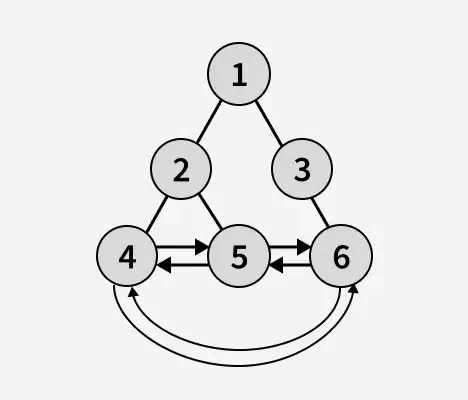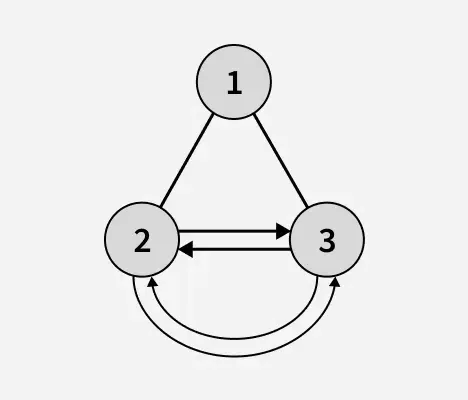Biorąc pod uwagę A specjalne drzewo binarne którego węzły liściowe są połączone tworząc a okrągła podwójnie połączona lista zadaniem jest znaleźć wysokość drzewa.
Przykłady:
numpy linspace
Wejście:

Wyjście: 2
Wyjaśnienie: Wysokość drzewa binarnego po rozpoznaniu węzłów liściowych wynosi 2. W powyższym drzewie binarnym 6 5 i 4 to węzły liściowe i tworzą one okrągłą, podwójnie połączoną listę. Tutaj lewy wskaźnik węzła liścia będzie działał jako poprzedni wskaźnik okrągłej podwójnie połączonej listy, a jego prawy wskaźnik będzie działał jako następny wskaźnik okrągłej podwójnie połączonej listy.Wejście:

Wyjście: 1
Wyjaśnienie: Wysokość drzewa binarnego po rozpoznaniu węzłów liściowych wynosi 1. W powyższym drzewie binarnym 2 i 3 są węzłami liściowymi i tworzą okrągłą, podwójnie połączoną listę.pasmo podstawowe vs łącze szerokopasmowe
Zbliżać się :
zaczyna się od Javy
C++Pomysł jest taki, aby podążać podobne podejście tak jak my to robimy znalezienie wysokości normalnego drzewa binarnego . My rekurencyjnie obliczać wysokość z lewy i prawy poddrzewa węzła i przypisz wysokość do węzła jako maks wysokości dwójki dzieci plus 1. Ale lewe i prawe dziecko a węzeł liścia mają wartość null dla normalnych drzew binarnych. Ale tutaj węzeł liścia jest okrągłym, podwójnie połączonym węzłem listy. Zatem, aby węzeł był węzłem liścia, sprawdzamy, czy lewa strona węzła wskazuje na węzeł i jego prawe i lewe wskazuje także na węzeł się.
// C++ program to calculate height of a special tree // whose leaf nodes forms a circular doubly linked list #include
// C program to calculate height of a special tree // whose leaf nodes forms a circular doubly linked list #include
// Java program to calculate height of a special tree // whose leaf nodes forms a circular doubly linked list class Node { int data; Node left right; Node(int x) { data = x; left = null; right = null; } } class GfG { // function to check if given // node is a leaf node or node static boolean isLeaf(Node node) { // For a node to be a leaf node it should // satisfy the following two conditions: // 1. Node's left's right pointer should be // current node. // 2. Node's right's left pointer should be // current node. // If one condition is met it is guaranteed // that the other condition is also true. return node.left != null && node.left.right == node && node.right != null && node.right.left == node; } // Compute the height of a tree static int findTreeHeight(Node node) { // if node is NULL return -1. if (node == null) return -1; // if node is a leaf node return 0 if (isLeaf(node)) return 0; // compute the depth of each subtree and take maximum return 1 + Math.max(findTreeHeight(node.left) findTreeHeight(node.right)); } public static void main(String[] args) { Node root = new Node(1); root.left = new Node(2); root.right = new Node(3); root.left.left = new Node(4); root.left.right = new Node(5); root.left.left.left = new Node(6); // Given tree contains 3 leaf nodes Node l1 = root.left.left.left; Node l2 = root.left.right; Node l3 = root.right; // create circular doubly linked list out of // leaf nodes of the tree // set next pointer of linked list l1.right = l2; l2.right = l3; l3.right = l1; // set prev pointer of linked list l3.left = l2; l2.left = l1; l1.left = l3; System.out.println(findTreeHeight(root)); } }
# Python program to calculate height of a special tree # whose leaf nodes forms a circular doubly linked list class Node: def __init__(self data): self.data = data self.left = None self.right = None # function to check if given # node is a leaf node or node def isLeaf(node): # For a node to be a leaf node it should # satisfy the following two conditions: # 1. Node's left's right pointer should be # current node. # 2. Node's right's left pointer should be # current node. # If one condition is met it is guaranteed # that the other condition is also true. return (node.left and node.left.right == node and node.right and node.right.left == node) # Compute the height of a tree def findTreeHeight(node): # if node is NULL return -1. if node is None: return -1 # if node is a leaf node return 0 if isLeaf(node): return 0 # compute the depth of each subtree and take maximum return 1 + max(findTreeHeight(node.left) findTreeHeight(node.right)) if __name__ == '__main__': root = Node(1) root.left = Node(2) root.right = Node(3) root.left.left = Node(4) root.left.right = Node(5) root.left.left.left = Node(6) # Given tree contains 3 leaf nodes l1 = root.left.left.left l2 = root.left.right l3 = root.right # create circular doubly linked list out of # leaf nodes of the tree # set next pointer of linked list l1.right = l2 l2.right = l3 l3.right = l1 # set prev pointer of linked list l3.left = l2 l2.left = l1 l1.left = l3 print(findTreeHeight(root))
// C# program to calculate height of a special tree // whose leaf nodes forms a circular doubly linked list using System; class Node { public int data; public Node left right; public Node(int x) { data = x; left = null; right = null; } } class GfG { // function to check if given // node is a leaf node or node static bool isLeaf(Node node) { // For a node to be a leaf node it should // satisfy the following two conditions: // 1. Node's left's right pointer should be // current node. // 2. Node's right's left pointer should be // current node. // If one condition is met it is guaranteed // that the other condition is also true. return node.left != null && node.left.right == node && node.right != null && node.right.left == node; } // Compute the height of a tree static int findTreeHeight(Node node) { // if node is NULL return -1. if (node == null) return -1; // if node is a leaf node return 0 if (isLeaf(node)) return 0; // compute the depth of each subtree and take maximum return 1 + Math.Max(findTreeHeight(node.left) findTreeHeight(node.right)); } static void Main(string[] args) { Node root = new Node(1); root.left = new Node(2); root.right = new Node(3); root.left.left = new Node(4); root.left.right = new Node(5); root.left.left.left = new Node(6); // Given tree contains 3 leaf nodes Node l1 = root.left.left.left; Node l2 = root.left.right; Node l3 = root.right; // create circular doubly linked list out of // leaf nodes of the tree // set next pointer of linked list l1.right = l2; l2.right = l3; l3.right = l1; // set prev pointer of linked list l3.left = l2; l2.left = l1; l1.left = l3; Console.WriteLine(findTreeHeight(root)); } }
// JavaScript program to calculate height of a special tree // whose leaf nodes forms a circular doubly linked list class Node { constructor(data) { this.data = data; this.left = null; this.right = null; } } // function to check if given // node is a leaf node or node function isLeaf(node) { // For a node to be a leaf node it should // satisfy the following two conditions: // 1. Node's left's right pointer should be // current node. // 2. Node's right's left pointer should be // current node. // If one condition is met it is guaranteed // that the other condition is also true. return node.left && node.left.right === node && node.right && node.right.left === node; } // Compute the height of a tree function findTreeHeight(node) { // if node is NULL return -1. if (node === null) return -1; // if node is a leaf node return 0 if (isLeaf(node)) return 0; // compute the depth of each subtree and take maximum return 1 + Math.max(findTreeHeight(node.left) findTreeHeight(node.right)); } const root = new Node(1); root.left = new Node(2); root.right = new Node(3); root.left.left = new Node(4); root.left.right = new Node(5); root.left.left.left = new Node(6); // Given tree contains 3 leaf nodes const l1 = root.left.left.left; const l2 = root.left.right; const l3 = root.right; // create circular doubly linked list out of // leaf nodes of the tree // set next pointer of linked list l1.right = l2; l2.right = l3; l3.right = l1; // set prev pointer of linked list l3.left = l2; l2.left = l1; l1.left = l3; console.log(findTreeHeight(root));
Wyjście
3
Złożoność czasowa: O(n) gdzie N to liczba węzłów.
Przestrzeń pomocnicza: Oh)


